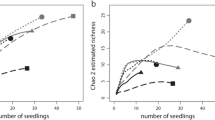Abstract
We investigated the association between ectomycorrhizal (ECM) and arbuscular mycorrhizal (AM) fungi and pioneer woody plant species in areas devastated by the eruption of Mt. Usu, Japan, in 2000. We observed eight woody plant species at the research site, most of which were associated with ECM and/or AM fungi. In particular, dominant woody plant species Populus maximowiczii, Salix hultenii var. angustifolia and Salix sachalinensis were consistently associated with ECM fungi and erratically associated with AM fungi. We found one to six morphotypes in the roots of each ECM host and, on average, two in the roots of each seedling, indicating low ECM fungal diversity. ECM colonization ranged from 17 to 42% of root tips. Using morphotyping and molecular analyses, 15 ECM fungi were identified. ECM fungi differed greatly between hosts. However, Laccaria amethystea, Hebeloma mesophaeum, Thelephora terrestris and other Thelephoraceae had high relative colonization, constituting the majority of the ECM colonization in the roots of each plant species. These ECM fungi may be important for the establishment of pioneer woody plant species and further revegetation at Mt. Usu volcano.

Similar content being viewed by others
References
Allen MF, Crisafulli C, Friese CF, Jeakins SL (1992) Re-formation of mycorrhizal symbioses on Mount St Helens, 1980–1990: interactions of rodents and mycorrhizal fungi. Mycol Res 96:447–453
Ashkannejhad S, Horton TR (2006) Ectomycorrhizal ecology under primary succession on coastal sand dunes: interactions involving Pinus contorta, Suilloid fungi and deer. New Phytol 169:345–354
Baxter JW, Dighton J (2001) Ectomycorrhizal diversity alters growth and nutrient acquisition of grey birch (Betula populifolia) seedlings in host-symbiont culture conditions. New Phytol 152:139–149
Fujiyoshi M, Kagawa A, Nakatubo T, Masuzawa T (2005) Successional changes in mycorrhizal type in the pioneer plant communities of a subalpine volcanic desert on Mt. Fuji, Japan. Polar Biosci 18:60–72
Gardes M, Bruns TD (1993) ITS primers with enhanced specificity for basidiomycetes—application to the identification of mycorrhizae and rusts. Mol Ecol 2:113–118
Goto H (1937) Revegetation of Volcano Tokachidake after the peculiar eruption in 1926. J Jpn For Soc 19:537–550
Harley JL, Harley EL (1987) A check-list of mycorrhiza in the British flora. New Phytol (Supplement) 105:1–102
Horton TR, Bruns TD (2001) The molecular revolution in ectomycorrhizal ecology: peeking into the black-box. Mol Ecol 10:1855–1871
Jumpponen A, Trappe JM, Cazares E (2002) Occurrence of ectomycorrhizal fungi on the forefront of retreating Lyman Glacier (Washington, USA) in relation to time since deglaciation. Mycorrhiza 12:43–49
Landeweert R, Leeflang P, Smit E, Kuyper T (2005) Diversity of an ectomycorrhizal fungal community studied by a root tip and total soil DNA approach. Mycorrhiza 15:1–6
Nara K (2006) Ectomycorrhizal networks and seedling establishment during early primary succession. New Phytol 169:169–178
Nara K, Nakaya H, Hogetsu T (2003a) Ectomycorrhizal sporocarp succession and production during early primary succession on Mount Fuji. New Phytol 158:193–206
Nara K, Nakaya H, Wu B, Zhou Z, Hogetu T (2003b) Underground primary succession of ectomycorrhizal fungi in a volcanic desert on Mount Fuji. New Phytol 159:743–756
Obase K, Tamai Y, Miyamoto T, Yajima T (2005) Macrofungal flora on the volcano Usu, deforested by 2000 eruptions. Eurasian J For Res 8:65–70
Phillips JM, Hayman DS (1970) Improved procedures for clearing roots and staining parasitic and vesicular–arbuscular mycorrhizal fungi for rapid assessment of infection. Trans Br Mycol Soc 55:158–161
Püttsepp Ü, Rosling A, Taylor AFS (2004) Ectomycorrhizal fungal communities associated with Salix viminalis L. and S. dasyclados Wimm. clones in a short-rotation forestry plantation. For Ecol Manag 196:413–424
Reddy MS, Natarajan K (1997) Coinoculation efficacy of ectomycorrhizal fungi on Pinus patula seedlings in a nursery. Mycorrhiza 7:133–138
Titus JH, Tsuyuzaki S (2002) Arbuscular mycorrhizal distribution in relation to microsites on recent volcanic substrates of Mt. Koma, Hokkaido, Japan. Mycorrhiza 12:271–275
Trowbridge J, Jumpponen (2004) Fungal colonization of shrub willow roots at the forefront of a receding glacier. Mycorrhiza 14:283–293
Tsuyuzaki S (1987) Origin of plants recovering on the volcano Usu, northern Japan, since the eruptions of 1977 and 1978. Vegetatio 73:53–58
Tsuyuzaki S, Hase A, Niinuma H (2005) Distribution of different mycorrhizal classes on Mount Koma, northern Japan. Mycorrhiza 15:93–100
van der Heijden EW, Vosatka M (1999) Mycorrhizal associations of Salix repens L. communities in succession of dune ecosystems. Mycorrhizal dynamics and interactions of ectomycorrhizal and arbuscular mycorrhizal fungi. Can J Bot 77:1833–1841
Walker LR, del Moral R (2003) Primary succession and ecosystem rehabilitation. Cambridge University Press, Cambridge, UK
White TJ, Bruns T, Lee S, Taylor J (1990) Amplification and direct sequencing of fungal ribosomal RNA genes for phylogenetics. In: Innis MA, Gelfand DH, Sninsky JJ, White TJ (eds) PCR protocols: a guide to methods and applications. Academic, San Diego, pp 315–322
Yang G, Cha JY, Shibuya M, Yajima T, Takahashi K (1998) The occurrence and diversity of ectomycorrhizas of Larix kaempferi seedlings on a volcanic mountain in Japan. Mycol Res 102:1503–1508
Yoshii Y (1942) Plant communities on Mount Koma after eruption. Ecol Rev (Sendai) 8:170–226
Acknowledgment
We thank Dr. Y. Adikari for his help with fieldwork and critical advice. This study was supported by a grant-in-aid (16208032) from the Ministry of Education, Culture, Sports, Science and Technology of Japan.
Author information
Authors and Affiliations
Corresponding author
Rights and permissions
About this article
Cite this article
Obase, K., Tamai, Y., Yajima, T. et al. Mycorrhizal associations in woody plant species at the Mt. Usu volcano, Japan. Mycorrhiza 17, 209–215 (2007). https://doi.org/10.1007/s00572-006-0097-y
Received:
Accepted:
Published:
Issue Date:
DOI: https://doi.org/10.1007/s00572-006-0097-y




